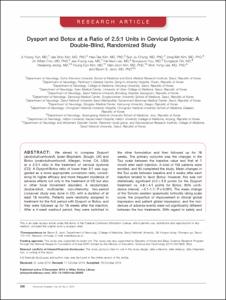Dysport and Botox at a Ratio of 2.5:1 Units in Cervical Dystonia: A Double-blind, Randomized Study
- Affiliated Author(s)
- 유수연
- Alternative Author(s)
- You, Soo Yeoun
- Journal Title
- Movement Disorders
- ISSN
- 0885-3185
- Issued Date
- 2015
- Abstract
- We aimed to compare Dysport (abobotulinumtoxinA, Ipsen Biopharm, Slough, UK) and Botox (onabotulinumtoxinA, Allergan, Irvine, CA, USA) at a 2.5:1 ratio in the treatment of cervical dystonia (CD). A Dysport/Botox ratio of lower than 3:1 was suggested as a more appropriate conversion ratio, considering its higher efficacy and more frequent incidence of adverse effects not only in the treatment of CD but also in other focal movement disorders. A randomized, double-blind, multicenter, non-inferiority, two-period crossover study was done in CD, with a duration of at least 18 months. Patients were randomly assigned to treatment for the first period with Dysport or Botox, and they were followed up for 16 weeks after the injection. After a 4-week washout period, they were switched to the other formulation and then followed up for 16 weeks. The primary outcome was the changes in the Tsui scale between the baseline value and that at 1 month after each injection. A total of 103 patients were enrolled, and 94 completed the study. Mean changes in the Tsui scale between baseline and 4 weeks after each injection tended to favor Botox; however, this was not statistically significant (4.0 ± 3.9 points for the Dysport treatment vs. 4.8 ± 4.1 points for Botox; 95% confidence interval, −0.1-1.7; P = 0.091). The mean change of the Toronto western spasmodic torticollis rating scale score, the proportion of improvement in clinical global impression and patient global impression, and the incidences of adverse events were not significantly different between the two treatments. With regard to safety and efficacy, Dysport was not inferior to Botox in patients with CD at a conversion factor of 2.5:1. [http//clinicaltrial.gov: NCT00950664] © The Authors. Movement Disorders published by Wiley Periodicals, Inc. on behalf of International Parkinson and Movement Disorder Society.
Keywords: cervical dystonia, torticollis, botulinum toxin, motor control, movement disorders
- Department
- Dept. of Neurology (신경과학)
- Publisher
- School of Medicine
- Citation
- Ji Young Yun et al. (2015). Dysport and Botox at a Ratio of 2.5:1 Units in Cervical Dystonia: A Double-blind, Randomized Study. Movement Disorders, 30(2), 206–213. doi: 10.1002%2Fmds.26085
- Type
- Article
- ISSN
- 0885-3185
- Appears in Collections:
- 1. School of Medicine (의과대학) > Dept. of Neurology (신경과학)
- 파일 목록
-
-
Download
 oak-aaa-03806.pdf
기타 데이터 / 354.34 kB / Adobe PDF
oak-aaa-03806.pdf
기타 데이터 / 354.34 kB / Adobe PDF
-
Items in Repository are protected by copyright, with all rights reserved, unless otherwise indicated.